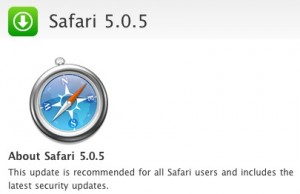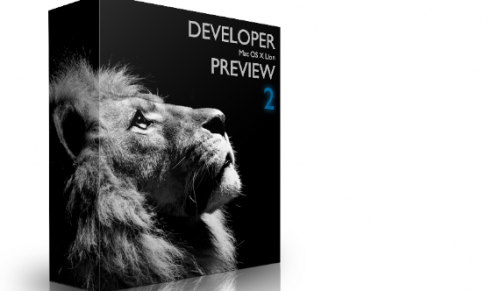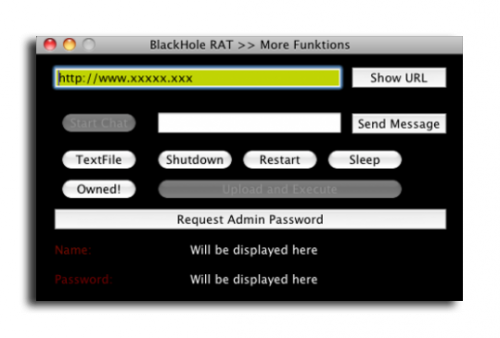News tagged ‘Mac OS X’
The Problems with a Retina Display on the Mac

The latest build of Lion includes some icons which are sized at 1024x1024. That's twice the current 512x512 size of icons in Snow Leopard. Additionally, on April 2nd, Mac blog OSXDaily found some of the default wallpaper resolutions in Lion to be as large as 3200×2000 pixels (see the shot below). A few observers noted that this is higher than any Apple display has ever supported, generating speculation that Apple is preparing for "Retina" display Macs in the near future.
Taking cues from iOS, Apple has reportedly built in support for what it calls "HiDPI display modes". These HiDPI modes allow developers to supply 2x-enlarged images to support double-high resolution displays. Like the iPhone 4's Retina Display, this means that user interface elements will remain the same size, but everything will be twice the resolution and therefore twice as detailed.
White iPhone 4 May Get Expose-like Multitasking Interface
Today Engadget found a video that suggests a white iPhone 4 might get a new Expose-style multitasking interface.
Read the rest of this entry »
Apple Releases Safari 5.0.5 and Security Update 2011-002
Alongside release of iOS 4.3.2, Apple also released Safari 5.0.5 and Security Update 2011-002 for Mac OS X. Safari 5.0.5 seems to simply include the latest security updates. The updates are available through Apple's download pages and through Software Update. Security Update 2011-002 is a small download for Snow Leopard users, but the Leopard versions are far and away larger files including even more changes than their Snow Leopard counterparts.
Safari 5.1 Gets “Do Not Track” On OS X Lion
According to The Wall Street Journal, Apple has added a “do-not-track” option in the latest developer build of OS X Lion to prevent advertisers and other web companies from tracking you online.
Apple Inc. has added a do-not-track privacy tool to a test version of its latest Web browser for keeping peoples’ online activities from being monitored by marketers. The tool is included within the latest test release of Lion, a new version of Apple’s Mac OS X operating system that’s currently available only to developers. The final version of the operating system is scheduled to be released to the public this summer. Mentions of the do-not-track feature in Apple’s Safari browser began to appear recently in online discussion forums and on Twitter.
This “do-not-track” option was originally offered by the FTC and was already built in Internet Explorer 9 and Firefox 4. The option may be enabled or disabled by a user at any time.
RedSn0w 0.9.6 rc11 released
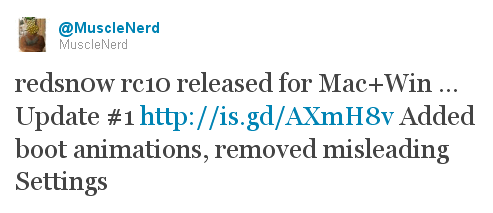
DevTeam released a new version of RedSn0w 0.9.6 rc10. Short after that they released a fix for that - RedSn0w 0.9.6 rc11.
DevTeam have added boot animation logo, removed some unnecessary settings, and fixed some bugs.
Everything else is the same - untethered jailbreak for iOS 4.3.1 for all devices and both Windows and Mac OS X users.
You can download the latest RedSn0w here.
Apple Releases Mac OS X Lion Developer Preview 2
Yesterday Apple released the second developer preview of Maс OS X Lion for testing purposes. The new Build 11A419 is not a Gold Master Candidate build, as it still contains many known issues that need to be fixed. Changes included in the update are currently unknown. It seems that the update is aimed at allowing developers to download future updates. Nevertheless, TechCrunch reports that this is indeed the "golden master candidate" build it discussed over the weekend and that the company is simply not going to push out a final release candidate until around its Worldwide Developer Conference in early June.
WWDC 2011 will be held on June 6-10
Apple has announced that the WWDC 2011 will be held on June 6-10 at the Moscone West Center in San Francisco. This year conference will be special because Apple is planning to introduce the next iOS version and preview Mac OS X Lion.
"At this year’s conference we are going to unveil the future of iOS and Mac OS,” said Philip Schiller, Apple’s senior vice president of Worldwide Product Marketing. “If you are an iOS or Mac OS X software developer, this is the event that you do not want to miss.”
The conference itself will be home to over 100 technical sessions and 1000 Apple engineers. Here are the specifics from Apple:
Mac OS X 10.7 Almost Ready For First Golden Master

TechCrunch reports that Apple is going to release the first golden master version of the forthcoming Mac OS X Lion to developers ahead of schedule. That means that Apple has essentially completed development on the new operating system version and will simply be fixing during the testing process. But this is only the initial Golden Master candidate. Although GMs usually mean the software will be shipping out to consumer’s soon.
Mac OS X Turns Ten Years Old

Yesterday Apple’s Mac OS X celebrated its 10th birthday! Mac OS X 10.0 deputed on March 24, 2001 and had a codename “Cheetah”. That release changed future not only the Mac platform but also the whole company turning it into the second most valuable company in the world. The early days of the platform was far from perfect, but already at that stage Mac OS X was called “tremendous promising”. Ars Technica noted in its extensive review of Mac OS X 10.0.0:
Apple released Mac OS X 10.6.7
Apple has released the latest update to the Snow Leopard operating system, Mac OS X 10.6.7. The 10.6.7 Update is recommended for all users running Mac OS X Snow Leopard and includes general operating system fixes that enhance the stability, compatibility, and security of your Mac, including fixes that:
- Improve the reliability of Back to My Mac;
- Resolve an issue when transferring files to certain SMB servers;
- Resolved an issue with mid-2010 MacBook Air kernel panics, AirPort driver issues;
- Improved brightness on external displays;
- Resolved a DVD player playback issue only seen on 64-bit Macs;
- Resolved the issue that could cause users accounts to disappear after the system went to sleep.
Eighth Beta of 10.6.7 Seeded to Developers
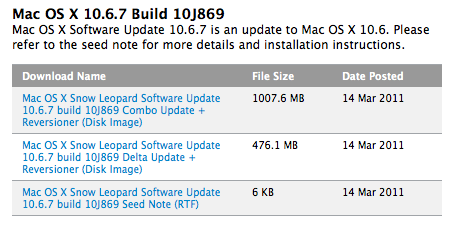
Apple has seeded a new 8th version of Mac OS X 10.6.7, termed Build 10J869, to developers for testing. According to those familiar with the new build, Apple doesn’t list known issues keeps asking developers to focus their testing on Safari, Mac App Store, AirPort, Bonjour, SMB, and Graphics Drivers. Very little change in file size leads us to think the final release of the OS update is nearing completion.
Safari 5.0.4 pwned at hacking contest in five seconds
As far as we know, the Apple’s browser Safari was always the subject of intense criticism for its various security weaknesses. A couple of days ago Safari got pwned again at the hacking challenge pwn2own. It took the French team consists of specialists of security firm Vupen just a few seconds to exploit an unpatched Safari vulnerability. “We pwned Apple Safari on Mac OS X (x64) at pwn2own in 5 seconds,” they tweeted. Just a few minutes before the contest, Apple released Safari 5.0.4 alongside iOS 4.3. Vupen said that the update 62 vulnerabilities, breaking “some exploits but not all.” The winners were awarded $15,000 and a MacBook Air. In addition to Safari, Microsoft’s Internet Explorer 8 was also hacked pretty quickly.
Step-by-step Tutorial: jailbreak iOS 4.2.1 on iPhone/iPod/iPad using PwnageTool 4.2 (Mac OS)
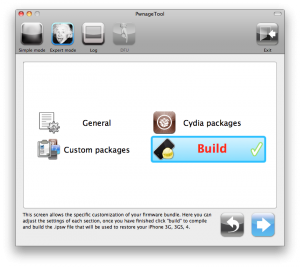
UPDate: Attention! We've received info, that Apple stopped signing iOS 4.2 for devices for which iOS 4.3 is available. This means you will not be able to restore to 4.2.1 without saved SHSH keys.
UPDATE: Please, consider reading our Jailbreak & Unlock FAQ, especially if you have questions or troubles.
Using this tutorial you will be able to jailbreak iOS 4.2.1 running on iPhone 3G, iPhone 3GS, iPhone 4, iPod Touch 3G, iPod Touch 4G and iPad. Pwnagetool will also preserve baseband version if you need carrier unlock. If you have updated the baseband to version 06.15, you can use this tutorial. This tutorial uses PwnageTool 4.2 for Mac OS X.
We are not developers of jailbreak utilities, so we cannot assure that everything will work just fine. However we tried this tutorial on several devices and succeeded.
We will use iPhone 4 in our jailbreak tutorial. The process is the same for all devices.
Step One
Make a folder called "Pwnage" on the desktop. Download a couple of things:
 Leave a comment, read comments [33]
Leave a comment, read comments [33]
Apple iPad 2 tech specs
Models |
 |
 |
||||
Size and Weight1 |
|
|
||||
Storage2 |
16GB
32GB
64GB
|
16GB
32GB
64GB
|
||||
New Remote Trojan Targets Growing Number of Mac OS X Users
It seams that malicious hacker put their hands on Mac computers. Security researchers report that hackers have a way to remotely send commands to your Mac OS X computer. “Blackhole” RAT, or Remote Access Trojan, allows hackers to control your Mac. SophosLabs analyzed the sample it received and determined that it is a variant of a well-known Remote Access Trojan (RAT) for Windows known as darkComet. The Blackhole RAT is available for download from the net, but there are no any reports from customers being hit by it.
The Trojan's basic functionality includes:
